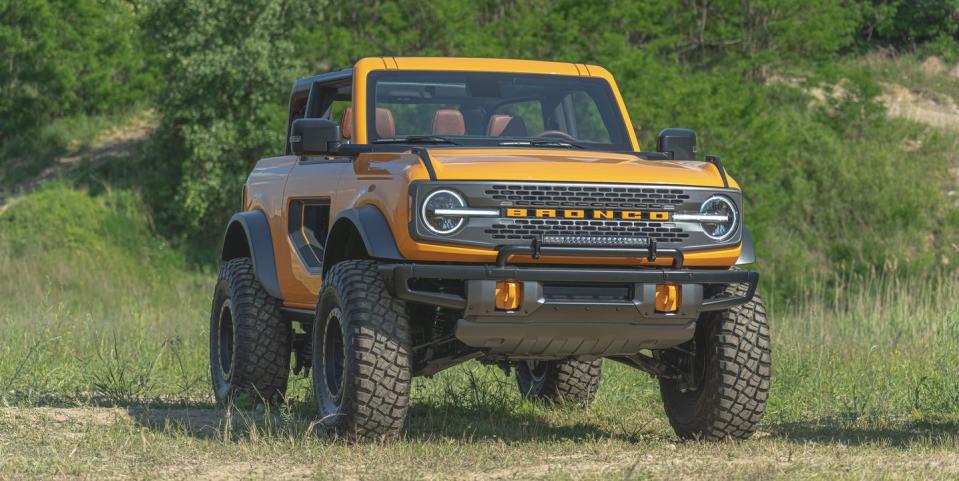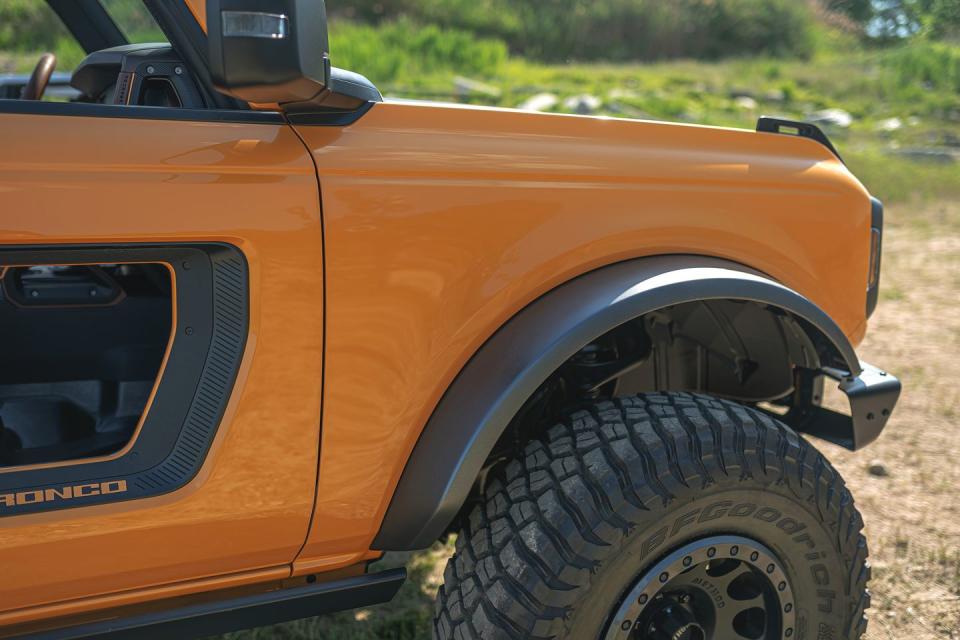2021 Ford Bronco Is Here, and It's Everything You Hoped For

The 2021 Ford Bronco made its debut tonight looking every bit like the Jeep Wrangler's worst nightmare, and Ford says dealers will have it next spring.
The new Bronco comes with a choice of two engines, both EcoBoost turbos, and in two- and four-door versions.
The base two-door starts at $29,995, but with 200 accessories, a desirable Sasquatch off-road package, and a choice of six trim levels with names like Black Diamond and Wildtrak, you're going to have some choices to make.
You can Sasquatch any trim to get the HOSS but you only get the creeper on the four. What are we talking about? Oh, just Bronco stuff. You gotta know the lingo, and Ford is introducing plenty of it. The 2021 Ford Bronco is here—or will be, at dealers, next spring—and with it comes a torrent of jargon. We'll explain all the details. But the first thing to know is that you're gonna want that Sasquatch package. Which comes with the HOSS, or "High-Performance Off-Road Stability Suspension."
The Bronco, available in both two- and four-door models, starts at $29,995 for a base two-door and $34,695 for the four-door. That setup comes with a 2.3-liter EcoBoost inline-four (projected to make 270 horsepower and 310 lb-ft of torque) and a seven-speed Getrag manual transmission. Ford likes to call first gear a crawler gear, which, when paired with the optional automatic four-wheel-drive transfer case, delivers a 94.8:1 crawl ratio—similar, actually, to a Wrangler Rubicon. The shift pattern puts that gear, "C", below reverse, to keep it out of the way during daily driving. The manual is only available with the 2.3, which can also be paired with a 10-speed automatic. The optional 2.7-liter EcoBoost V-6 is slated to make 310 horsepower and 400 lb-ft of torque. So whichever engine you choose, your Bronco is going to be turbocharged.

Six Trim Levels, Plus a First Edition
Whether or not to boost, then, is one decision Bronco customers won't have to make. Beyond that, the Bronco decision tree gets wild. You know how, when there's a hot new model, a car company will typically roll out some kind of launch-edition trim? The Bronco has that—dubbed First Edition, and kitted out with maximum off-road gear and luxury options—along with no fewer than six other trims. Above the base model, there's the Big Bend, which upgrades the 30-inch tires to 32 inches. Then comes the Black Diamond, which brings skid plates, rock rails and a locking rear differential. Outer Banks is your more luxury-oriented trim, sort of like a Wrangler Sahara. The Wildtrak is the desert runner, bringing the 2.7 V-6, 35-inch tires, and position-sensitive Bilstein dampers. And the Badlands is like a Wrangler Rubicon, optimized for gnarly trail work with 33-inch tires and a disconnecting front sway bar. The Badlands also comes with marine-grade vinyl upholstery and a rubberized hose-it-out floor, though you can option it up with a fancier interior.

Got all that? Good, because there's one more thing: the Sasquatch package. That's your primo off-road gear: 35-inch Goodyear Territory mud-terrain tires, a 4.70 final-drive ratio, locking front and rear Spicer differentials, 17-inch black-painted beadlock-capable wheels, high-clearance suspension and fender flares, and the Bilstein dampers. Sasquatch Broncos also get a full three inches of extra track width. The package can be added to any trim level, but it's standard on Wildtrak and First Edition. So your bang-for-the-buck off-road beast will be a base model with Sasquatch.
Ground Clearance & Fording Depth Are Impressive
Solid-axle enthusiasts will find one out back: a five-link Dana 44 with coil-overs. But even the old Broncos gave up solid front axles for 1980. So it's unsurprising that the 2021 Bronco uses an independent front end, which is advantageous for every situation outside of extreme off-road articulation. And even then, the Bronco offers a semi-active disconnecting front sway bar to enable the best possible articulation (you disconnect it via a button, but it reconnects automatically). Besides the dynamic benefits of IFS, including lower unsprung weight, the independent front end allows fitment of a sweet "bash plate" that protects the diff. The 11.6 inches of ground clearance for a two-door with 35-inch tires bests even the Raptor. And a max fording depth of 33.5 inches is getting into amphibious-vehicle territory.

The independent front end and turbo gas engines are two areas—but not the only ones—where the Bronco diverges from its most obvious benchmark (the one that rhymes with "Peep Tangler"). Ford looked beyond automotive reference points, too. For instance: the Polaris RZR side-by-side. The RZR might've influenced the Bronco's doors, which are frameless, like a side-by-side's, and removable. The doors store in fitted bags that you can take with you (in the four-door, anyway), though they do eat up pretty much all the cargo space behind the rear seat. Since the exterior rearview mirrors are mounted to the base of the A-pillar, you keep your mirrors even when the doors are off. Your move on that one, Jeep.

 Yahoo Autos
Yahoo Autos 